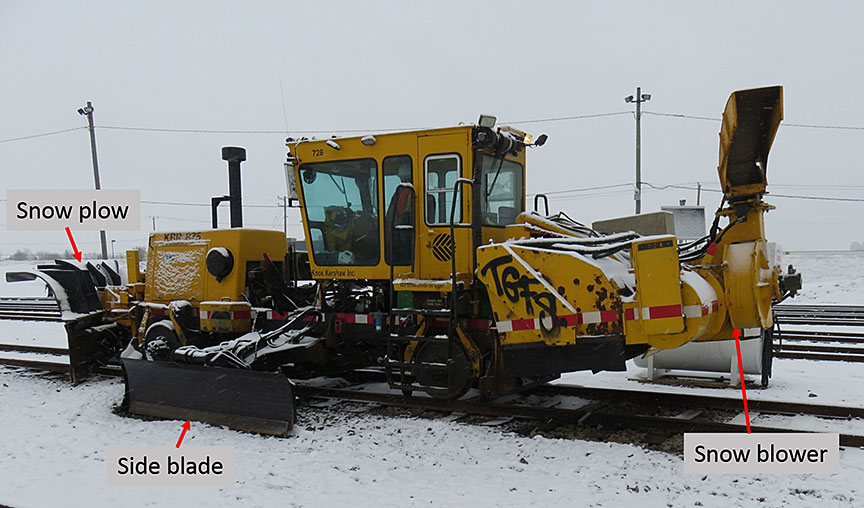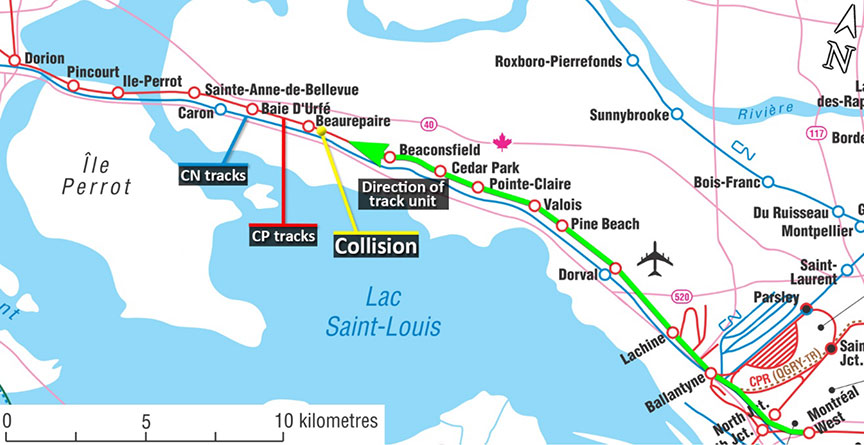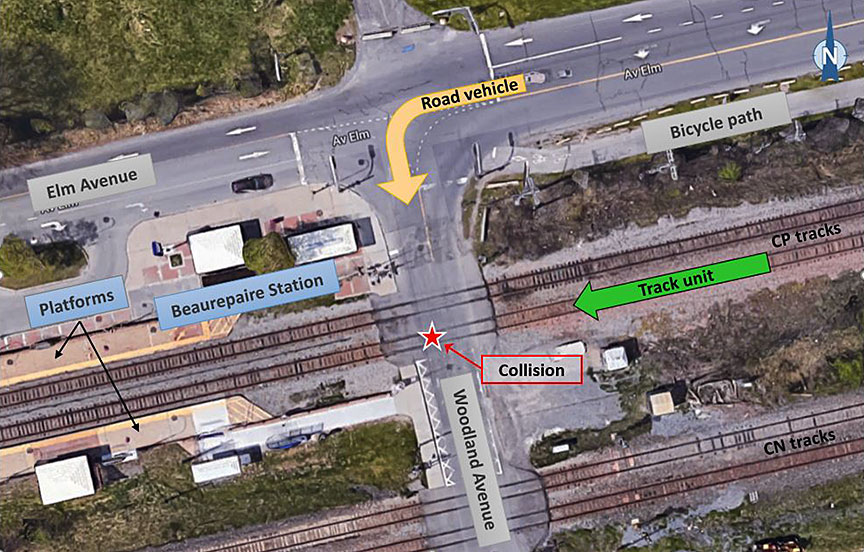Crossing collision
PNR RailWorks Quebec Inc.
Track unit PNR 728
Mile 12.15, Canadian Pacific Railway Vaudreuil Subdivision
Beaconsfield, Quebec
The Transportation Safety Board of Canada (TSB) investigated this occurrence for the purpose of advancing transportation safety. It is not the function of the Board to assign fault or determine civil or criminal liability. This report is not created for use in the context of legal, disciplinary or other proceedings. See Ownership and use of content. Masculine pronouns and position titles may be used to signify all genders to comply with the Canadian Transportation Accident Investigation and Safety Board Act (S.C. 1989, c. 3).
The occurrence
On 13 February 2018, at about 0930,Footnote 1 track unit PNR 728 (TU) (Figure 1), operated by PNR RailWorks Quebec Inc. (PNR), began snow-clearing operations between Dorion, Quebec, and Montréal-West, Quebec, on the Vaudreuil Subdivision. The TU was being operated by a PNR machinery operator (operator) supervised by a Canadian Pacific Railway (CP) foreman. The TU weighed approximately 25 tons and was 38 feet long. Both crew members were qualified for their respective positions and met established fitness and rest requirements. At the beginning of their work shift, during a briefing, it was agreed that the foreman would advise the operator whenever the TU was approaching a grade crossing.
After completing snow removal at Montréal-West, the TU had to get off the tracks to clear the way for the rush-hour commuter trains on the Vaudreuil-Hudson line of the Réseau de transport métropolitain. Unable to obtain permission from the rail traffic controller (RTC) to occupy the adjacent tracks while the TU changed direction,Footnote 2 the TU operator had to go back to Dorion, on the south track and in reverse, with the snow blower facing the direction of travel. At 1418, a track occupancy permit was issued to travel between Beaconsfield and Dorion.
At about 1440, the TU was travelling westward at approximately 20 mph when it approached the Woodland Avenue public crossing in Beaconsfield, Quebec, located at Mile 12.15 (Figure 2). When the TU was approximately 200 feet east of the crossing, the foreman advised the operator that the TU was approaching a crossing, as previously agreed. As the TU slowed, the operator noticed road vehicles moving at the crossing. He applied the emergency brake and lowered the snow plow to force the TU to slow down. The TU was unable to stop before it reached the crossing and it struck the rear end of a road vehicle.
After the TU came to a complete stop, the crew members, neither of whom had been injured, exited the TU to check on the condition of the driver. Police officers and ambulance attendants, who had been called by another driver, arrived on scene shortly after the collision. The driver, who was the sole occupant of the vehicle, sustained minor injuries and was treated on site by the ambulance attendants. Shortly after the collision, the foreman contacted his supervisor to report the collision, and the TU was moved to the east to clear the crossing.
At the time of the collision, the temperature was −7 °C and the sky was overcast.
Site examination
The collision occurred at a public crossing equipped with a warning system (bell, flashing lights, and gates) that was not activated by the TU.Footnote 3 The crossing traverses 4 tangent railway tracksFootnote 4 at a 90° angle in an urban neighbourhood. Elm Avenue is located to the north of the CP right-of-way and runs parallel to the tracks. A bicycle path, trees, and utility poles are located along the south side of Elm Avenue. The Beaurepaire commuter train station is located directly to the west of the crossing. There are passenger platforms on both sides of the CP tracks (Figure 3). The crossing gives road vehicles travelling on Elm Avenue access to Highway 20 and the southern part of the city of Beaconsfield.
After the collision, the TU came to a stop on the crossing, obstructing it. There was no apparent damage to the TU, the railway track, or the warning system. The surface of the crossing was partially covered with snow and there were no visible marks. The road vehicle came to a stop on the south side of, and parallel to, CP's south track. The road vehicle was struck above the rear axle on the left side. There was no fuel spill.
Information on the subdivisions that cross Woodland Avenue
The 4 tracks that cross Woodland Avenue are the main tracks of CP's Vaudreuil SubdivisionFootnote 5 and of the Canadian National Railway Company (CN) Kingston Subdivision.Footnote 6
In the area of the collision, railway trafficFootnote 7 consists of approximately 36 freight trains and 47 passenger trains per day. Whistling is prohibited in the area. The CP tracks are Class 4 tracks as defined in the Transport Canada–approved Rules Respecting Track Safety. The speed limit in the area is 55 mph for freight trains and 75 mph for passenger trains. The CN tracks are Class 5 tracks and the speed limit in the area is 65 mph for freight trains and 100 mph for passenger trains.
Sightline requirements
The sightline requirementsFootnote 8 in Transport Canada's Grade Crossings RegulationsFootnote 9 do not apply to grade crossings with a warning system and gates, but the warning system must be visible within the entire stopping sight distance.Footnote 10
Track unit PNR 728
The TU's last overall mechanical inspection had taken place on 27 December 2017; all noted defects were corrected. After the collision, the TU was inspected and no defects were noted. However, it was determined that mechanical inspections and repairs were not being recorded in the TU's logbook.
Road vehicle driver's actions
The road vehicle driver was familiar with the crossing. While travelling westward on Elm Avenue, he had stopped at the red light at the intersection with Woodland Avenue. While he was waiting, the crossing warning system activated because a freight train was travelling on a CN track. When the gates went up and the traffic light turned green, the road vehicle driver began moving to pass through the crossing. He was focussing on the road ahead and did not look both ways before crossing the tracks. While he was on the crossing, he noticed the approaching TU. The road vehicle driver did not try to stop or accelerate, and his vehicle was struck.
Track unit operator's actions
Operators must be prepared to stop their TUs before each crossing to confirm whether the crossing is clear of traffic. If the crossing is not clear of traffic, the TU may only proceed over the crossing when manual protection is provided, when the warning system is activated, or with caution when the operator is alone.Footnote 11
In this occurrence, because of the size of the side blades mounted on the TU, the operator was to ensure that the blades were lifted and locked when the TU was approaching passenger platforms at train stations or any other obstacle. To do so, the operator would slow down and use the control handle attached to the seat. When the TU was travelling east, the snow plow was facing forward and the operator was facing in the direction of the movement. When the TU was travelling west, the operator's view was partially obstructed by the snow blower.
When the operator was approaching the Woodland Avenue crossing, the foreman informed the operator as agreed. When the operator saw the platforms of the Beaurepaire train station in the distance, he slowed the TU to verify the position of the side blades. He was not familiar with the territory and did not notice that the crossing was immediately before the station rather than after it. When he heard the foreman reminding him that he was approaching a crossing, he became aware of the upcoming crossing. He immediately applied the emergency brake and lowered the snow plow, but was not able to stop the TU before the crossing.
Foreman's actions
The foreman was familiar with the territory. He was seated in a jump seat attached to the TU cabin wall. When the TU was travelling westward, because he was sitting with his back to the direction of travel, the foreman had to sit sideways and turn his head to look in the direction of the movement. As the TU approached the Woodland Avenue crossing, the foreman advised the operator as previously agreed. Since the TU was slowing down, it is likely that the foreman expected the TU to come to a stop before it reached the crossing. Realizing that the TU was not stopping, the foreman again warned the operator of the presence of the crossing.
PNR RailWorks Quebec Inc.
PNR's employees are regulated by the Canadian Rail Operating Rules and trained by PNR, and must pass a CP test. PNR's employees are qualified but are not necessarily familiar with all the territories.
After the collision, PNR discussed the collision with its employees. They were reminded to comply with the applicable rules when approaching grade crossings and to record all daily inspections in logbooks and on appropriate documents.
Other similar occurrences
From 2008 to 2017, 31 occurrences involving TUs at public crossings equipped with warning systems occurred on federally regulated tracks in Canada. The TSB investigated 1 of these occurrences.Footnote 12 The investigation determined that, despite the presence of a flag-person, a TU (multi-crane) was not able to stop before the crossing and struck a tractor-trailer. Given that the crossing warning system was not activated, the truck driver was expecting the crossing to be clear.
Safety message
When activated by rolling stock, crossing warning systems are an effective means of preventing accidents. Given that track units do not automatically activate warning systems, it is essential for TU operators to take extra caution and follow the established procedure at railway crossings to reduce the risk of accidents.
This concludes the TSB’s limited-scope investigation into this occurrence. The Board authorized the release of this investigation report on . It was officially released on .


